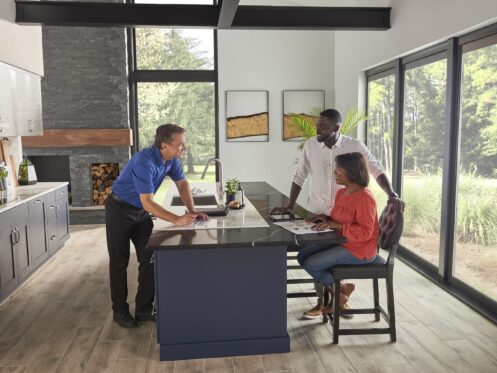If your doors slam shut on their own or you feel a draft every time someone turns on the dryer, you may be experiencing negative air pressure. It’s a tricky and frustrating issue that throws your whole system off balance. Heating, cooling, and even indoor air quality all suffer when pressure pulls outside air in through cracks and vents. Instead of just chasing symptoms, you’ll want to get to the root of the problem and fix the imbalance for good. Environmental Heating & Air Solutions in Benicia, CA, helps homeowners identify the sources of pressure and make adjustments before they cause more significant problems.
What Negative Air Pressure Looks Like in a House
You might not notice the issue right away. Maybe doors close on their own, or drafts pull in smells from the garage or basement. Those can be signs that your home has negative air pressure. That means more air is leaving your home than coming in. When that happens, your house pulls replacement air from wherever it can. You might feel it under door gaps or see dust pulling toward vents. That imbalance can disrupt your comfort, indoor air quality, and even your energy bills. It can also put stress on systems like your water heater if the flue gases can’t rise properly. You want your home to stay neutral, not suction itself like a vacuum.
What Causes Negative Pressure Indoors
Several things can throw your pressure balance off. Exhaust fans are common culprits. Bathroom fans, kitchen range hoods, or clothes dryers all push air out. That’s their job, but if your home is too tight or if fresh air can’t get back in, pressure drops. Sealed-up windows and doors might keep the heat in, but they also block return air. Your HVAC system can also make it worse if it pulls in too much from one side of the house and doesn’t balance it elsewhere. Large fireplaces or improperly sealed ductwork can exacerbate the problem. If you’re feeling air pulling inward around recessed lights, baseboards, or outlets, you might be dealing with a pressure problem caused by one or more of these sources.
Why You Shouldn’t Ignore It
It’s easy to brush it off as a quirk, but that imbalance can create bigger issues. Negative pressure can pull moisture into the walls, especially when outdoor air seeps in through cracks. That moisture might lead to mold or rot in areas you don’t see every day. It can also draw in contaminants from crawlspaces or attics, where air isn’t filtered. If you have combustion appliances, such as a gas furnace or water heater, backdrafting becomes a risk. That means flue gases might not leave your home the way they should. Instead, they stay inside, which could result in a carbon monoxide hazard.
How Your HVAC System Plays a Role
Your heating and cooling system might be making the problem worse without you realizing it. If your return vents aren’t balanced with your supply vents, you create zones where pressure drops. Your system works harder trying to pull air from one side and push it to another. Some homes have oversized return ducts or supply fans that create more imbalance than they fix. If you’ve ever noticed your system kicking on but certain rooms still feel stale or chilly, uneven pressure could be part of the reason. Your HVAC system should keep the air moving smoothly, not suck it in uneven chunks.
Testing for Pressure Problems
You don’t need fancy equipment to spot the signs, but professional tools do make a difference. One quick test you can do is crack a window slightly and turn on all your exhaust fans. If the window air rushes in fast, your home might be running on a pressure deficit. Professionals use manometers to get a better picture. That tool helps check the difference between indoor and outdoor pressure and shows how the building envelope is reacting to fans and vents. If you’ve already noticed drafts, unexplained smells, or weird door behavior, it’s worth having a technician take a closer look. The tools can show what your house is doing even when you can’t feel it clearly.
Simple Fixes That Can Help
Once you know what’s causing the imbalance, you can start to fix it. Some homes benefit from adding makeup air systems, which bring in fresh outdoor air when exhaust systems run. Others need ductwork repairs or air return adjustments to move air more evenly through the house. You might need a small change, like adjusting fan runtimes or using a smart thermostat to keep pressure more balanced. Air sealing helps, too, but only when it’s paired with a plan for fresh air. Sealing everything tight without managing intake air just makes the pressure issue worse. You want a system that breathes with purpose, not one that fights itself.
Pay Attention to Where You Feel It
Not every room shows the same signs. You might notice cold drafts near exterior doors or warm, musty air drifting in from the attic. If you find yourself avoiding one room because it always feels off, you may be standing in a pressure pocket. These spaces show up when air moves unevenly through the house. Your HVAC system could be serving other areas well, but it is skipping that room entirely. You may also have a disconnected vent or an underpowered fan contributing to the issue. Paying attention to those small details makes it easier to spot what’s out of balance. A technician can trace it back from where you feel it to its origin.
Makeup Air Isn’t Just for Commercial Buildings
Many people assume that makeup air systems only appear in restaurants or large buildings. However, homes also benefit from them, especially if you have high-powered range hoods or multiple exhaust fans running daily. These systems let you bring in filtered, conditioned air when the exhaust pulls air out. That stops your house from pulling in dusty attic air or musty crawlspace air to make up the difference. You maintain balanced pressure without compromising comfort or air quality. Some makeup air systems even connect to your HVAC, so the temperature stays where you want it while the balance stays neutral.
Ventilation and Filtration Go Hand in Hand
Once you start pulling outdoor air in to balance pressure, you also need to filter it. That’s where integrated ventilation systems come into play. They bring in air but also clean it before it reaches your living space. Without that filter, pollen, dust, or humidity can tag along. Filtration is especially important if you or anyone in the home deals with allergies or respiratory conditions. You want clean air coming in, not just any air. Systems that combine ventilation with filtration give you both without making your HVAC system work harder. They help maintain pressure balance while keeping your indoor environment comfortable and healthier.
How Building Materials Affect Pressure Balance
The materials your home was built with play a part in how air moves. Older homes with wood framing and less insulation tend to leak air in places you wouldn’t expect. That can make pressure swings feel more dramatic from season to season. On the other hand, newer homes often get sealed tight with spray foam, insulated sheathing, and energy-efficient windows. While that’s great for temperature control, it can trap stale air inside and stop outside air from coming in when exhaust fans run. If your house feels stuffy even with the AC on or if you’ve noticed lingering odors that won’t go away, your building envelope might be too airtight without balanced ventilation.
Schedule a Negative Air Pressure Evaluation Now
Negative pressure rarely shows up all at once. It builds slowly, throwing off comfort, wasting energy, and stressing your equipment without you noticing until something feels off. Tackling it early helps you protect your home’s airflow and avoid bigger headaches down the line. To get your airflow back on track, schedule an evaluation today with Environmental Heating & Air Solutions. You can also get services like air balancing, ductwork inspections, and ventilation upgrades from us.

